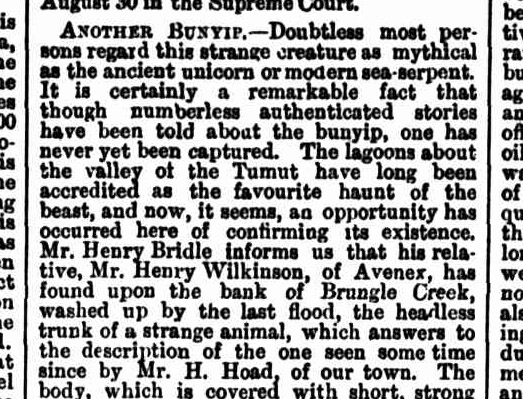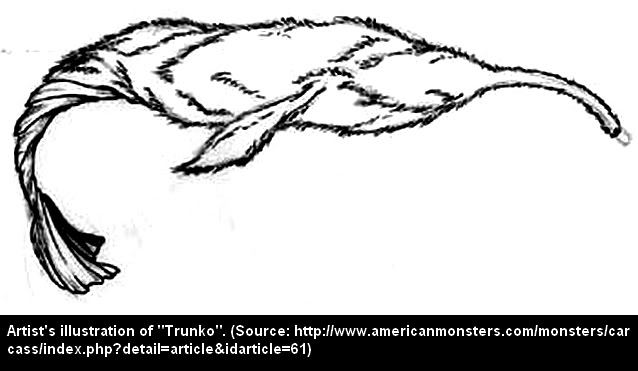1883, September 6 (pre): The Brungle Creek Monstrosity
On September 6, 1883, newspapers in the Southern half of Australia carried a report that a very strange corpse had been found at Brungle Creek in New South Wales. The article appeared in several different newspapers between September 6 and September 15, with just a little variation. The report stated that a Mr. Henry Wilkinson of Avener -- or Avenner, or Avenex (all towns I can't find!) -- had found an unusual animal corpse washed up on the banks of Brungle Creek after the last flood in the area.
The body was "a headless trunk of a strange animal" covered with short, strong hair and an overall pig-like appearance. The "terminal appendage curls inward, and resembles the tail of a huge lobster." There was damage on the corpse where it was felt the head and feet should be, and it was assumed these had been eaten away by animals. The flesh in these damaged spots was described as looking like "dried ling fish," and the body overall was in a "similar state of preservation" and "shows no sign of decay"... so, presumably, it had dried out before being carried away by the flood.
This unusual specimen was said to be similar to another strange corpse seen "some time since" by a Mr. H. Hoad of Tumut (about 18 miles/30 km from Brungle Creek), but no more details are given on that matter. The reporter hoped (perhaps jokingly) that the corpse would be sent to the Sydney Museum, a possibility of which I'll have to check on when I can. That sums up all that the newspaper article states factually about the matter; yet the story went on to have an extended life. But First: Bunyips.
Bunyips... a bit of a pain

The newspaper article appeared in all the papers with the heading of "Another Bunyip," and ended with a local tale of some bushmen who were surprised by a 'bunyip' near the area the corpse was found.
'Bunyips,' you see, are a legendary animal in Australia. When the settlers first arrived to the continent they heard many tales of a strange beast that inhabited the waterways from the locals -- a beast with magic powers, that could sometimes speak, and that was never described in any precise way. At the time, the settlers decided the stories were in fact just stories; but in the late 1800's hunting for an actual biological creature to associate with the bunyip legends became a going fad. Because of this, the word 'bunyip' started to be used in newspapers to label any unknown creature found in Australia... hence the title "Another Bunyip." I will do a fuller study of the claims regarding Australia's bunyips at a later time; for now, just know that this particular incident continued to pop up whenever someone wanted to talk about bunyips. In America, however, there is no discussion of bunyips... and that's where the newspaper story was changed in 1931.
Charles Fort Strikes!
Charles Fort [1874-1932] is an American author famous for four books he wrote that collected strange and unexplained events he gleaned from newspaper articles worldwide... and that included the article above, which he found in the Adelaide Observer for September 15, 1883, a newspaper out of Adelaide, Australia. Fort, unfortunately, also loved to make a good story better, often cutting them down to just the bare details, and sometimes mis-representing or mis-quoting what an article said. For instance, here's what he wrote in his 1931 book LO! about the article currently in question:
"Remains of a strange animal, teleported to this earth from Mars or the moon -- very likely, or not so likely -- found on a bank of a stream in Australia. See the Adelaide Observer, Sept. 15, 1883 -- that Mr. Hoad, of Adelaide, had found on a bank of Brungle Creek, a headless trunk of a pig-like animal, with an appendage that curved inward, like the tail of a lobster."
So Fort presented Mr. Hoad as the discoverer, not Mr. Wilkinson; he also states that Hoad was from Adelaide, which is an easy mistake to make. Only one copy of the article that I've seen states that Mr. Hoad was from Tumut, which is a town very close to Brungle Creek; this article was from Penrith, which is the closest town to Brungle Creek that I've gotten a copy of the story from. Every other repetition of the article I've seen simply says "Mr. H. Hoad, of our town," no matter what town the newspaper was in. So Fort assumed Mr. Hoad was from Adelaide because he saw the article in the Adelaide Observer... but Hoad was most likely from Tumut.
Fort also slimmed down the details of the corpse to present an animal that was only missing its head, and with the implication it was a fresh carcass. And, because many publications on weird topics that came after Charles Fort used his books as if they were factual representations, Fort's version of the story became the main story told from 1931 on... well, until 2010 anyway, when it was re-written again!
If it's on the Internet, it's True... right?
On February 7, 2010, the tale of the Brungle Creek corpse was posted on the website American Monsters, a site with a stated goal of creating "an all encompassing reservoir of information regarding every unknown animal" which started (as the site's title implies) with just reports from the Americas, but was later expanded to include reports from around the world. Unfortunately, if what they did with the Brungle Creek story is an indicator of how they researched, then there's a good reason the site is now dead.
The story, as the American Monsters site told it, was that in September of 1883 Mr. Hoade, a native of Adelaide, Australia, had discovered the body of an animal on the banks of Brungle Creek that "defied any hope of rational explanation." They claimed that Hoade had described the creature in the Adelaide Observer for September 15, 1883, as being about 30-feet long with no apparent head, possessing an "elephantine trunk" and a curved appendage at the rear that resembled a lobster's tail. They also claimed that Charles Fort's take on the animal was that it was in fact from out of this world, quoting his "remains of a strange animal, teleported to this earth from Mars or the moon" comment as proof.
It's pretty clear in comparison with both Charles Fort's brief listing and with the details of the earliest report (both given above), that the team at American Monsters never encountered anything more than Fort's listing of the Brungle Creek story... but they wanted to act as if they had. They misspelled Mr. Hoad's name -- which was spelled correctly by Fort -- while repeating Fort's mistakes of identifying Hoad as the discoverer, and as a native of Adelaide. Worse still, they appear to have invented the new details of the creature's length and having an elephantine trunk -- ignoring Fort's use of the word 'trunk' as to mean 'the main part of a body' -- in a strange attempt to relate the Brungle Creek beast to a monster reported in 1922 that was nicknamed 'Trunko.' To help cement this idea, the website also created an illustration of what they proposed the Brungle Creek corpse looked like:

American Monster's imaginative illustration of the Brungle Creek corpse [Larger version here]
Note that they added longer hair and flippers as well... which is more in line with the reported appearance of the 1922 'Trunko' report, a matter I will handle separately in the future. What this illustration does not resemble though, is a headless, dried-out, pig-like corpse with short strong hair and clearly missing a head and legs due to scavenging... which is what was actually reported in the Adelaide Observer and other newspapers from 1883.
Unfortunately, despite the fact that the American Monsters website is now gone, many other 'cryptozoology' websites have gone on to repeat the fictional report of the Brungle Creek corpse to support a claim for an unknown type of hairy whale with a trunk!
Did it happen...?
This is a question I often pose. Ignoring the way the story changed in 1931 and 2010, the question is whether or not we should distrust the initial reports from 1883... and I must admit, I have two main hesitations on the matter.
First off, all of the copies of the repeating story I could trace were not the first report... every one of them claimed the original report came from the Tumut & Adelong Times, which is the one newspaper I cannot easily find online. Tumut, the town the newspaper comes from, is only 18miles/30km from Brungle Creek, whereas all the newspapers I've found the article in come from towns ranging between 249 miles/400 km to 625 miles/1001 km away... so it's unlikely any of them were in a position to verify the details they reported. So I will have to contact some libraries in Tumut and try to find the earlier article (if it exists).
The second problem is a very practical one... where did Mr. Henry Wilkinson, the stated discoverer of the corpse, come from? His home was variously described as Avener, Avenner, and Avenex, none of which are town names in Australia. This problem may be ultimately why Charles Fort left Wilkinson out when he retold the story, but there's no way to be sure now.
So this matter remains marked as "Under Investigation" until I can find out more about the possibility of a report in the August or September 1883 editions of the Tumut & Adelong Times... I'm curious as to if the monstrosity was just the invention of an erstwhile 'reporter' or if the monstrosity was actually monstrous!
Anomalies -- the Strange & Unexplained, as well as my other website -- Monsters Here & There -- are supported by patrons, people like you! All new Anomalies articles are now posted for my patrons only, along with exclusive content made just for them. You can become a patron for just $1 a month!
|








